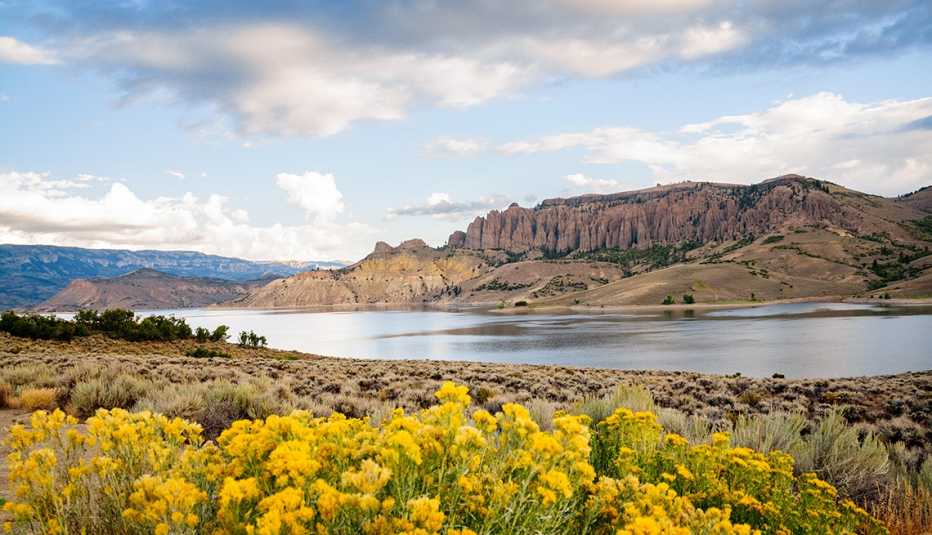AARP Hearing Center
Charcoal-dark cliffs towering up to 2,700 feet above the Gunnison River frame one of North America’s deepest canyons, more than double the depth of the Grand Canyon of the Yellowstone. But it’s the canyon’s walls, hewn from Precambrian basalt and marbled with veins of pink granite, that impress the most. Just 40 feet apart at the narrowest point, they enclose the river so tightly that parts of the canyon never see sunlight, lending the landscape the eerie darkness that earned the canyon its name: Black Canyon of the Gunnison.
It’s not hard to understand why the U.S. government deemed this geological marvel in remote southwestern Colorado, 2 million years in the making, worthy of protection as a national monument in 1933 and elevated it to national park status in 1999.
“What makes the Black Canyon so stunning and singular is its steepness, deepness and narrowness combined,” says Lori Rome, the park’s chief of interpretation. “I don’t think most people are expecting it, and when they look over the rim for the first time, they’re just in awe.”


Facts Box
Location: Montrose County, Colorado
Acreage: 30,750
Highest point: 8,775 feet
Lowest point: 5,400 feet (at the river)
Main attraction: The canyon, as seen from several viewpoints
Entry fee: $30
Best way to see it: By car
When to go to avoid the crowds: Late August through mid-June
The Gunnison River earns its own superlatives, including for the steepness of its descent, which averages 43 feet a mile and accelerates to some 240 feet per mile in Chasm View. Compare that with the Colorado River’s average drop of 7.5 feet a mile and it’s easy to see why the gorge’s Class V rapids are a proving ground for expert kayakers and a draw for hikers seeking to hear its thunder. The roar of the river rising from the canyon is so loud it can be heard at any spot, providing a musical backdrop punctuated by the falcons, eagles and other birds that call the area home.
The 47-square-mile park is divided into two sections separated by the canyon — the more-traveled South Rim and the more remote North Rim. Most visitors head to the South Rim, which has more overlooks that jut out over the canyon. The drive between the two rims takes about 2 hours. Note: The last 7 miles of the road to the North Rim is unpaved gravel and closed in the winter.
Relatively undeveloped, with few amenities beyond a visitor center, the compact park is an ideal alternative to the other more crowded canyon parks.
It’s also easy to see and appreciate, with all its star attractions close to the main roads. “It’s a great park for older adults or those who don’t want to walk a lot, because you can see so much from viewpoints on the road and close to the car,” says Rome, noting that three are accessible for people who have mobility issues.
While the landscape is enough to keep camera-happy explorers riveted as they try to capture its angles and depths, there’s more to do here than look. Hiking, biking, fishing and winter sports are all popular. And adjacent Curecanti National Recreation Area, which the park comanages, adds 42,000 acres for active endeavors.


Plan your trip
Given its remote location, Black Canyon takes some effort to reach from the region’s largest cities, with Denver 250 miles to the northeast; Albuquerque, 334 miles to the south; and Salt Lake City, 354 miles to the northwest. The small town of Moab, Utah, is about 186 miles to the west, so some national park fans tack Black Canyon onto a tour of the “Mighty 5” red rock national parks: Arches, Bryce Canyon, Canyonlands, Capitol Reef and Zion.
Reservations are not required to enter the park. On the South Rim, rangers are stationed at a traditional national park kiosk between 9 a.m. to 4 p.m. in the winter and 8 a.m. to 5 p.m. in the summer, Mountain Time (MT). Outside those hours, you’ll use a self-payment system (entry fee, $30). At the North Rim entrance, a kiosk is open only intermittently, with the self-payment system used most of the time.
You’ll find the park’s only visitor center — the South Rim Visitor Center — about a mile from the entrance. Rangers are on hand to help orient visitors to the park, plus you’ll find a detailed topographic model and a well-curated bookstore. Don’t miss the documentary vividly depicting the geological forces that shaped the canyon.


With elevations ranging up to 8,775 feet, the park experiences significant seasonal weather and temperature variations. In summer, high temperatures range from 60 to 100, and afternoon thunderstorms are common. In winter, they range from 20 to 40 degrees and can dip below zero on especially cold days. Weather in the spring and fall is unpredictable; both seasons offer temperate daytime temperatures ranging from the high 50s through the low 80s, with nights that can drop into the 30s.
Yarrow, paintbrush and other wildflowers line the trails in spring. Come fall, in a stunning show, aspens burnish the mountain slopes with bronze and crimson, and the cottonwoods line the river with molten gold.
While South Rim Drive is closed from mid-November to late April, it’s plowed as far as Gunnison Point, where the South Rim Visitor Center remains open from 9 a.m. to 4 p.m.
There is no cell service in the park.



































































